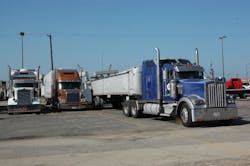There’s an old Chinese curse I’ve quoted before in this space that seems very applicable to the trucking industry these days: “May you live in interesting times.”
And boy oh BOY are the times getting interesting in trucking these days.Apart from the frightening (and violent) chaos now being visited upon many parts of the world right now – Syria, Iraq, and the Ukraine to name just a few – that could at any moment upend the global economic apple cart, the outlook for trucking here in the U.S. is looking good and getting better by the day.
Despite projections for continued slow economic growth for America this year and next (click here to read more about that) trucking is poised to do well because it remains very short on capacity.
Don Thornton, senior VP for DAT Solutions, delved into this very topic in a great report issued earlier this week dubbed What’s Causing the Capacity Crunch and What Can Shippers Do About It.
And while his analysis focuses on helping shippers overcome capacity constraints, it illustrates why those constraints developed in the first place – squeezing the bottom lines of motor carriers and thus triggering increases in freight rates for shippers; increases that are only just beginning.
“Factors that are constraining capacity and driving rates higher include new and more stringent regulations, extreme weather, increased operating costs, and a chronic shortage of experienced drivers,” Thornton explained.“Some of these factors were predictable, but the resulting capacity disruptions and skyrocketing rates were an unpleasant surprise,” he added.
“In some cases, long-standing business relationships were jeopardized, as transportation providers and their customers struggled to explain and understand the impact of all these factors on capacity and pricing commitments,” he pointed out.
Thornton turned the clock back to the unruly winter weather in the first quarter to document how all of those factors listed above created a “domino effect” of sorts regarding capacity and rates.
“Shippers typically negotiate annual transportation contracts in the first quarter [as] at that time, Christmas is over, demand is slack, and capacity is abundant,” he explained. “Against this seasonal background, when spot market rates are typically at their lowest point of the year, transportation and logistics companies bid on the shippers’ requests for quotes (RFQ) and the coming year’s contracts are solidified.”
However, in 2014, that model broke down for many shippers and their transportation and logistics providers, Thornton stressed.
“Capacity was scarce in the first quarter because the storms were so severe and widespread; major cities were pummeled repeatedly in the Midwest, Northeast and even the Southeast,” he pointed out. “Carriers were able to negotiate high per-mile rates on ‘exception freight’ –meaning freight moved outside the contractual arrangements between a shipper and carrier – during that period, but the weather cost them a large proportion of their loaded miles, reducing overall revenue.”Thus when shippers began the bid process during the first quarter, with many intending to increase their 2014 transportation budgets by less than 5%, motor carriers were inclined to hold out for bigger increases as they were preoccupied with lost revenues and spiraling costs.
“In that frame of mind, [carriers] were more likely than usual to seek larger rate increases and limit their commitments, preferring to bid only on freight that dovetailed well with other business opportunities,” Thornton said.
“Carriers [that] took on suboptimal routes, perhaps as a favor to a good customer, began to impose strict limits on the number of those commitments at a given contract rate,” he emphasized. “Anything beyond the contracted number of loads per week, for example, might be subject to variable, market-based pricing.”
On top of that, many industry analysts now estimates that as much as 40% of truck freight is arranged on an “exception” basis, with much of that priced on a transactional basis using spot market rates, Thornton noted.
Thus so-called “exception” freight may comprise a larger portion of trucking cargo than was previously estimated, increasing the relevance to shippers of spot market capacity and rate, he said.On top of all that, since the hours of service (HOS) rules were reformed in July 2013, fleets gave up an estimated 5% to 7% of their productivity on longer hauls, Thornton noted.
Drivers are now permitted to be on duty for no more than 14 hours per day, with only 11 hours behind the wheel with a mandatory 30-minute break occurring within the first eight hours. After seven days on duty, the driver must reset his clock with a 34-hour off-duty period that includes two segments from 1:00 AM to 5:00 AM.
“That last requirement is especially troublesome,” Thornton emphasized. “The restart provision puts a disproportionate share of big trucks on the road in major metropolitan areas during the morning rush hour. Timing mandatory breaks can also be tricky for long-haul drivers who are under time pressures and may not find legal, safe parking spots at precisely timed intervals.”
Not only then did that combination of rules make it more difficult for drivers to operate safely while adhering to tight delivery schedules, the overall HOS-induced productivity losses led directly to trucking rate increases.
“Instead of a typical third quarter decline, rates rose when the new rule took effect in July 2013, and they remained elevated through the third quarter,” Thornton pointed out.
Remember, too, that diesel fuel is anything but cheap – hovering at or near $4.00 per gallon for more than a year – and that HOS-productivity losses translate into reduced miles and thus pay for drivers. As a result, more drivers are demanding higher pay per mile, plus benefits and improved working conditions, to compensate for reduced productivity, he noted.Equipment costs continue to rise every year as well, in no small part due to addition of expensive exhaust emission control systems required by law, with upfront tractor sticker prices now ranging between $115,000 and $125,000 per unit for just a base model, according to analysis by Frost & Sullivan.
As a result, such factors are driving total cost of operation or TCO calculations higher for trucking firms. Indeed, DAT figures that on a per-mile basis, carriers today might require an average of $1.75 to $1.80 or more per mile for all miles, loaded and empty alike, in order to break even.
“For that reason, for-hire carriers cannot afford to run an empty truck, and a low rate can be acceptable in one direction only if a high-paying return trip boosts the round-trip average comfortably above a break-even rate,” DAT’s Thornton said.
Like many in the freight business now, Thornton thinks one way shippers can navigate through this “capacity crunch” is by using “big data” to more effective “model” freight volume and pricing by lane.
“Data from a company’s own history is used to build operational models of costs, revenues, opportunities and challenges associated with transportation and logistics choices,” he explained. “Then different variables are applied to create scenarios that help with forecasting and contingency planning.”
Market-specific and lane-based data allows for a heretofore unavailable level of “transparency” Thornton argued, with an analysis of current and historic demand, capacity and rate data allowing shippers to benchmark their own costs or prices against prevailing rates and marketplace conditions.
Yet that still may mean in the end that shippers have to raise their freight pay offerings in order to attract available capacity.
We’ll see how all that plays out in the coming months for sure.





